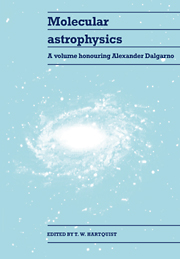Refine listing
Actions for selected content:
17000 results
3 - Parameter estimation using Monte Carlo sampling
-
-
- Book:
- Bayesian Methods in Cosmology
- Published online:
- 11 April 2011
- Print publication:
- 10 December 2009, pp 57-78
-
- Chapter
- Export citation
1 - Foundations and algorithms
-
-
- Book:
- Bayesian Methods in Cosmology
- Published online:
- 11 April 2011
- Print publication:
- 10 December 2009, pp 3-35
-
- Chapter
- Export citation
Part I - Methods
-
- Book:
- Bayesian Methods in Cosmology
- Published online:
- 11 April 2011
- Print publication:
- 10 December 2009, pp 1-2
-
- Chapter
- Export citation
3 - Protoplanetary disk evolution
-
- Book:
- Astrophysics of Planet Formation
- Published online:
- 05 June 2012
- Print publication:
- 10 December 2009, pp 65-108
-
- Chapter
- Export citation
Preface
-
- Book:
- Astrophysics of Planet Formation
- Published online:
- 05 June 2012
- Print publication:
- 10 December 2009, pp ix-x
-
- Chapter
- Export citation
13 - Photometric redshift estimation: methods and applications
-
-
- Book:
- Bayesian Methods in Cosmology
- Published online:
- 11 April 2011
- Print publication:
- 10 December 2009, pp 283-298
-
- Chapter
- Export citation
Appendix 2 - N-body methods
-
- Book:
- Astrophysics of Planet Formation
- Published online:
- 05 June 2012
- Print publication:
- 10 December 2009, pp 264-272
-
- Chapter
- Export citation
7 - Bayesian source extraction
-
-
- Book:
- Bayesian Methods in Cosmology
- Published online:
- 11 April 2011
- Print publication:
- 10 December 2009, pp 167-192
-
- Chapter
- Export citation
1 - Observations of planetary systems
-
- Book:
- Astrophysics of Planet Formation
- Published online:
- 05 June 2012
- Print publication:
- 10 December 2009, pp 1-33
-
- Chapter
- Export citation
12 - A Bayesian approach to galaxy evolution studies
-
-
- Book:
- Bayesian Methods in Cosmology
- Published online:
- 11 April 2011
- Print publication:
- 10 December 2009, pp 265-282
-
- Chapter
- Export citation
Index
-
- Book:
- Bayesian Methods in Cosmology
- Published online:
- 11 April 2011
- Print publication:
- 10 December 2009, pp 299-303
-
- Chapter
- Export citation
Frontmatter
-
- Book:
- Astrophysics of Planet Formation
- Published online:
- 05 June 2012
- Print publication:
- 10 December 2009, pp i-iv
-
- Chapter
- Export citation
6 - Giant planet formation
-
- Book:
- Astrophysics of Planet Formation
- Published online:
- 05 June 2012
- Print publication:
- 10 December 2009, pp 185-217
-
- Chapter
- Export citation
References
-
- Book:
- Astrophysics of Planet Formation
- Published online:
- 05 June 2012
- Print publication:
- 10 December 2009, pp 273-280
-
- Chapter
- Export citation
9 - Gravitational wave astronomy
-
-
- Book:
- Bayesian Methods in Cosmology
- Published online:
- 11 April 2011
- Print publication:
- 10 December 2009, pp 213-228
-
- Chapter
- Export citation

Molecular Astrophysics
- A Volume Honouring Alexander Dalgarno
-
- Published online:
- 10 December 2009
- Print publication:
- 12 April 1990
Appendix 1 - Physical and astronomical constants
-
- Book:
- Astrophysics of Planet Formation
- Published online:
- 05 June 2012
- Print publication:
- 10 December 2009, pp 263-263
-
- Chapter
- Export citation
8 - Flux measurement
-
-
- Book:
- Bayesian Methods in Cosmology
- Published online:
- 11 April 2011
- Print publication:
- 10 December 2009, pp 193-212
-
- Chapter
- Export citation
7 - Early evolution of planetary systems
-
- Book:
- Astrophysics of Planet Formation
- Published online:
- 05 June 2012
- Print publication:
- 10 December 2009, pp 218-262
-
- Chapter
- Export citation
5 - Bayesian experimental design and model selection forecasting
-
-
- Book:
- Bayesian Methods in Cosmology
- Published online:
- 11 April 2011
- Print publication:
- 10 December 2009, pp 99-125
-
- Chapter
- Export citation
